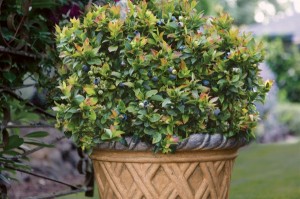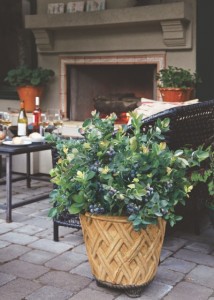
Northsky lueberry harvest. (C) Jo Ellen Meyers Sharp
Ok, the blueberry harvest did not fill a bushel, but it did provide just enough of the sweet fruit in a green salad for a family dinner.
This is year three of ‘Northsky’ and it’s the first real harvest. I bought this plant four falls ago just because of the gorgeous, red leaves. The fact that it might produce blueberries was sort of a bonus.

BrazelBerries Jelly Bean blueberry. Photo courtesy BrazelBerries
Consumer interest in the anti-oxidant fruit powerhouse is high and the breeders have responded with dwarf plants and those that are self-pollinating.
The dwarf ‘Northsky’ (Vaccinium) gets up to 3 ½ feet tall and 3 feet wide. Mine grows in a 20-inch wide and deep all-weather container. By growing it in a container, I’m able to control the soil environment the blueberry needs to survive and thrive. That means regular doses of Espoma’s Holly-Tone, an acidic fertilizer. Blueberry plants require an acidic soil in order be able to take up the nutrients they need to survive.

BrazelBerries Peach Sorbet blueberry. Photo courtesy of Brazelberries
Last summer and this spring I was vigilant about fertilizing the shrub. Too late for this spring, I learned the plant should be pruned to encourage better fruit production along main branches.
‘Northsky’ produces the most fruit when it has a companion, such as ‘Northblue’ or ‘Northcountry’.
Last year I added three more dwarf blueberries to trial from BrazelBerries: two Peach Sorbet and one Jelly Bean. The new blueberries are bred to be grown in containers and are self-pollinating, but there was no fruit this year. I think it’s because they were tiny when I planted them last fall. Peach Sorbet gets its name because of the foliage color in fall. It gets 2 to 3 feet tall and wide. Jelly Bean is even smaller at 1 to 2 feet tall and wide.
Although there was no fruit, these new blueberries are growing well. And, as most gardeners say, it will be better next year.